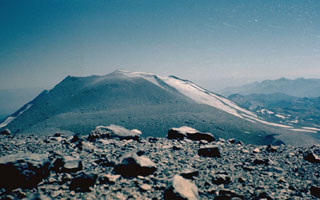Report on Nevados de Chillan (Chile) — June 2016
Bulletin of the Global Volcanism Network, vol. 41, no. 6 (June 2016)
Managing Editor: Edward Venzke.
Research and preparation by Jackie Gluck.
Nevados de Chillan (Chile) Eruptive episode begins in January 2016 with phreatic explosions
Please cite this report as:
Global Volcanism Program, 2016. Report on Nevados de Chillan (Chile) (Venzke, E., ed.). Bulletin of the Global Volcanism Network, 41:6. Smithsonian Institution. https://doi.org/10.5479/si.GVP.BGVN201606-357070
Nevados de Chillan
Chile
36.868°S, 71.378°W; summit elev. 3180 m
All times are local (unless otherwise noted)
A small eruption from Nevados de Chillán during August-September 2003 was the first since 1986 (BGVN 29:03). Subsequent activity included ash plumes in 2009, and since December 2015, heightened seismic activity, phreatic explosions, and gas and steam emissions from fumaroles. Nevados de Chillán is a group of stratovolcanoes with Cerro Blanco (Volcán Nevado) at the NW end, Volcán Viejo (Volcán Chillán) at the SE end, with a group of lava domes known as Volcán Nuevo in the middle; the 1973-1986 Volcán Arrau dome complex is SE of Volcán Nuevo.
This report covers activity from 2009 through May 2016. With the exception of the Buenos Aires Volcanic Ash Advisory Center (VAAC) report in January 2009, all of the information has been provided by Chile's Servicio Nacional de Geología y Minería (SERNAGEOMIN) - Observatorio Volcanológico de Los Andes del Sur (OVDAS).
Based on Significant Meteorological Information (SIGMET) and analysis of satellite imagery, the Buenos Aires VAAC reported that during 21-22 January 2009, ash plumes rose to altitudes of 3.7-6.1 km and drifted 50-80 km SE. No other information or ground confirmation of ash emission is available about this activity, and no other activity was reported over the next seven years.
The webcam recorded a small white plume on 9 December 2015 rising from the crater. On 31 December 2015, SERNAGEOMIN-OVDAS reported that both seismicity and hydrothermal system activity had increased, prompting an elevation of the Alert Level to Yellow (on a 3-color scale). They also noted the installation of two new seismic stations as well as three GPS stations, with real-time transmission. During December 2015 the seismic network recorded 1,259 seismic events, including 186 volcano-tectonic (VT) earthquakes, 1,030 long-period (LP) earthquakes, 40 short episodes of spasmodic tremor, and three tornillo-type events. The majority of these events were concentrated around the southern cone of the complex at a depth of less than 5 km.
A phreatic explosion at 1755 on 8 January 2016, associated with an LP earthquake, generated a short-duration ash emission. At least one additional phreatic ash explosion occurred on 9 January. During an overflight that same day, volcanologists observed a new crater on the E flank of the Volcán Nuevo lava-dome complex, about 40 m from the edge of the crater. On 29 January a phreatic explosion at 1425 from the Arrau dome complex generated an ash emission that was associated with a seismic tremor signal. During an overflight on 30 January, volcanologists observed that the series of recent phreatic explosions had formed a new crater about 50 m from Arrau Crater, on the E flank. The new crater was 25-30 m wide and at a similar elevation as the crater formed on 8 January.
Monitoring stations registered a VT earthquake at 0635 on 11 February 2016, located 5.3 km SE of Chillán at a depth of 1 km. During 16-29 February 2016, the seismic network recorded 579 seismic events, including 65 VT earthquakes, 510 LP earthquakes, and four discreet tremors. Webcams showed steam emissions from a small fumarole rising to a maximum height of 300 m above the crater.
On 18 March 2016 the number of LP earthquakes increased to 3-4 events per minute starting at 0844. During 1-15 April steam rose from the Arrau dome complex; a small amount of ash was present in the emissions during 7-9 April, rising at most 400 m. On 9 May at 1303, seismic stations recorded an explosion that generated a plume that rose 1.7 km above the crater rim.
Geological Summary. The compound volcano of Nevados de Chillán is one of the most active of the Central Andes. Three late-Pleistocene to Holocene stratovolcanoes were constructed along a NNW-SSE line within three nested Pleistocene calderas, which produced ignimbrite sheets extending more than 100 km into the Central Depression of Chile. The dominantly andesitic Cerro Blanco (Volcán Nevado) stratovolcano is located at the NW end of the massif. Volcán Viejo (Volcán Chillán), which was the main active vent during the 17th-19th centuries, occupies the SE end. The Volcán Nuevo lava-dome complex formed during 1906-1945 on the NW flank of Viejo. The Volcán Arrau dome complex was then constructed on the SE side of Volcán Nuevo between 1973 and 1986, and eventually exceeded its height. Smaller domes or cones are present in the 5-km valley between the two major edifices.
Information Contacts: Servicio Nacional de Geología y Minería (SERNAGEOMIN) (URL: http://www.sernageomin.cl/volcanes.php); Observatorio Volcanológico de los Andes del Sur (OVDAS), Temuco (URL: http://www.sernageomin.cl/volcan-observatorio.php); Oficina Nacional de Emergencia Ministerio del Interior (ONEMI) (URL: http://www.onemi.cl/); Buenos Aires Volcanic Ash Advisory Center (VAAC), Servicio Meteorológico Nacional-Fuerza Aérea Argentina, 25 de mayo 658, Buenos Aires, Argentina (URL: http://www.smn.gov.ar/vaac/buenosaires/inicio.php?lang=es).

